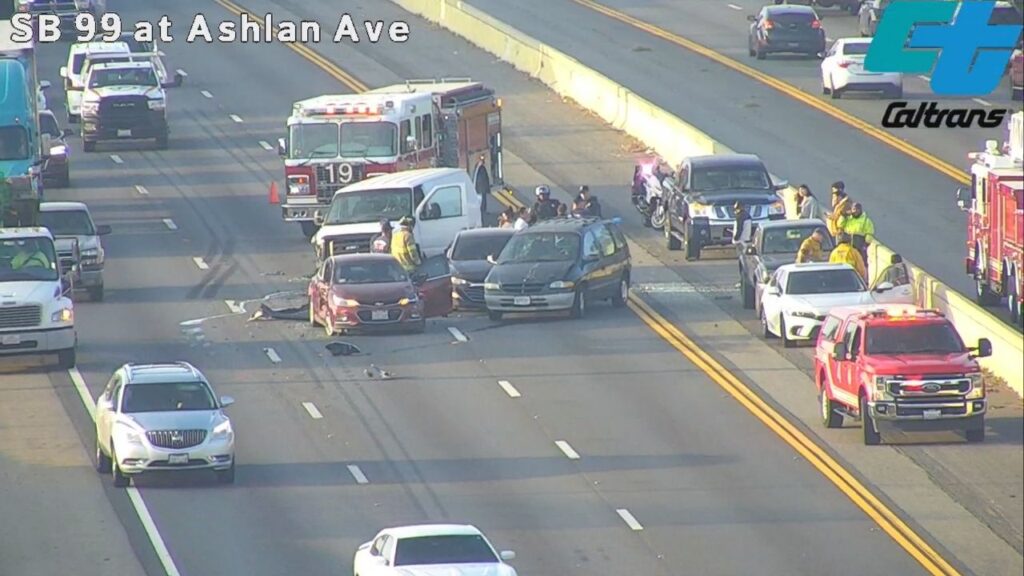Share
|
Getting your Trinity Audio player ready...
|
Aleka Jackson-Jarrell is the coordinator of the Heritage Program at Adelanto High in California’s High Desert. She regularly meets with Black students at the school to make sure they stay on track to graduate and meet A-G requirements that enable them to apply to a public university.

Emma Gallegos
EdSource

Daniel J. Willis
EdSource
Christian Robinson always planned to go to college, but when she graduated from Adelanto High School in California’s High Desert, she felt aimless. Without a plan or preparation for higher education, she decided to go to work instead.
She regrets that now.
“I wish I would have gone straight into college because I would have had everything done, finished and over with,” said Robinson, who at 20 is now enrolling at Victor Valley College.
Currently, Robinson juggles two jobs, working for a security company and serving fast food. She wishes she had received more guidance about attending college from her school.
Robinson’s story was typical for Black students at Adelanto High School, where over 8 out of 10 Black students graduated in 2020 without the college prep courses — known as A-G — required for admission to California’s public universities.
(This article originally appeared on EdSource.)
The Different Paths of Siblings
The path has been different for her younger brother MarQuan Thornton, currently a high school senior at Adelanto. Months away from graduation, Thornton is one of a small group of students deciding not whether he will go to college, but which one.

(EdSource/Emma Gallegos)
Thornton has worked hard but recognizes that the key difference between his trajectory and his sister’s is the support he’s getting from school that did not exist during his sister’s time there.
Three years after his sister graduated, his high school began the Heritage Program, which is aimed at ensuring that Black students, like him, are on track to complete their A-G requirements.
Thornton knows he’s on track to meet the requirements that will make him eligible to attend a state university.
“If she (Christian Robinson) had this type of chance when she was in high school, she probably would have been where I am at,” Thornton said. “I can see the difference.”
California’s Graduation and A-G Completion Rates
While the vast majority of students in California — 86% of seniors in 2023 — graduate from high school, most — 56% in 2023 — do not complete their A-G requirements, according to an EdSource analysis of data from the California Department of Education. EdSource’s analysis found that Black and Latino students are the hardest hit.
In 2023, 68% of Black students and 64% of Latino students did not meet A-G requirements, compared with 26% of Asian students and 48% of white students, according to EdSource’s analysis.
The highest non-completion group is foster students at 88%, followed by disabled students at 85% and English learners at 82%.
“These kinds of numbers should be treated as a five-alarm fire,” said Melissa Valenzuela-Stookey, director of P-16 research for Ed Trust-West, a nonprofit that advocates for justice in education.
Valenzuela-Stookey said high school graduates are being shut out of affordable four-year public college options, because they are not getting the support they need to complete the A-G coursework.
“Our education systems urgently need to invest more in our students of color,” Valenzuela-Stookey said.
The Impact of the Pandemic
As Robinson neared graduation in the early days of the pandemic, she said everyone, even teachers, seemed to lose track of how to prepare students for college and life after high school.
But long before the pandemic, the district was not preparing its Black students to meet their A-G requirements and be ready for higher education, according to Ratmony Yee, assistant superintendent of educational services for Victor Valley Union High.
Robinson’s mother, Crystal Francisco, says that she is proud of how hard her daughter works to earn her own money. But she concurs that if Heritage had been around, Robinson might have gone straight to college.
“She probably would have gone a different way,” said Francisco.
Snapshot of California
Of 1,766 high schools in California, about half graduated more than 56% of students lacking the required college preparatory courses.
Fewer than 2 out of 10 students met A-G rates in 2023 in many northern counties, such as Lake, Del Norte, Plumas, Lassen, Nevada, Tehama, Trinity. Just 3 out of 10 students in Kern, Merced, Tulare and Kings counties met the requirements. That compares to the Bay Area in San Mateo, Santa Clara, Alameda and Marin counties where more than 5 out of 10 students met A-G requirements.

Improving Low A-G Completion Rates
Improving low A-G completion rates has been a longtime goal of both educators and state policymakers, but it’s a problem that resists easy answers or quick fixes, said Sherrie Reed, executive director of the California Education Lab at UC Davis and a researcher with Policy Analysis for California Education (PACE), an independent research nonprofit affiliated with several California universities.
The idea of simply aligning the state’s minimum high school requirements with A-G requirements hasn’t gained steam because of the concern that it would result in fewer students graduating, said Mayra Lara, the director of Southern California partnerships and engagement with Ed Trust-West.
What Are A-G Requirements?
The details of A-G requirements can be arcane, especially for students and parents who are not familiar with the college admissions process. The state requires students to complete a minimum of 13 courses to receive a high school diploma. But to attend a UC or CSU requires that a student takes 15 courses in seven areas: history, English, math, science, foreign language, arts and an elective. Each category has its own letter, A-G, which is where the requirements get their name. These courses overlap with high school requirements, but they are also more rigorous. For instance, three years of English are required to graduate from high school, while A-G eligibility requires four years. Only one of those years can include English as a Second Language or English Language Development — courses that English learners are often enrolled in. Low grades are a common way students fall off the A-G track. A “D” is considered a passing grade for a high school diploma, but A-G classes require at least a “C” to count as eligible.
The state, instead, has offered carrots for districts working on improving poor A-G rates, especially those that have a large marginalized student population, such as those who are low-income, English learners, homeless or have a disability. In 2021-22, the state set aside over $547 million for the A-G Completion Improvement Grant Program. The state has also pushed dual enrollment and career technical education to the high school curriculum, both of which can help students meet their A-G requirements.
Progress has been slow. The number of students who have met A-G requirements statewide has ticked up just shy of four points over the last six years.
Understanding why any given student may or may not meet A-G requirements requires examining what is happening in a particular region or district, as well as disparities within schools.
“The answer is that it is all of that,” said Reed. “No one factor accounts for it.”
Graduating Without Meeting A-G Requirements
Some students said that graduating without meeting A-G requirements sent them the message that they were not college material.
Brock Wooster-Mills, 20, said he felt “doomed to fail” as a student with a disability attending Liberty High School in Bakersfield, where 49% of students do not meet A-G requirements.
Partial hearing loss had affected Wooster-Mills’ ability to speak and follow lessons in elementary school. But even when his hearing improved, his counselors in the Kern High School District wouldn’t allow him to transfer into required A-G courses such as French and geometry.
He remembers one special education teacher telling his class that they likely wouldn’t even attend a community college, but Wooster-Mills said he always knew he was capable of more. He enrolled in Bakersfield College in 2021, the fall after he graduated.
He’s now in his sixth semester, but his lack of academic confidence and inadequate preparation continue to dog him. In high school, he had never been taught how to write an essay. He had never studied a foreign language, which made Spanish daunting. He failed the first time he took it.
“I feel like I’m still behind,” he said. “I wasn’t taught what I was supposed to be taught.”
College Increasingly Important for Economy
Researchers say that preparing students for college is increasingly important for the American economy. By 2031, 72% of jobs will require a college degree or post-secondary education such as an associate degree, according to the Georgetown University Center on Education and the Workforce.
Most high schools in the state — 91.4% of traditional district schools, according to PACE — do offer a full slate of A-G coursework that put them on track for college. But the degree of access students get to those courses or support, once they have enrolled, varies greatly, resulting in wide disparities between groups of students.
Interactive Map
View the map to see the percentage of students in each high school who graduate without A-G required courses.
PACE released a series of briefs and reports on the A-G completion rates in summer 2023, noting that access to rigorous coursework — whether dual enrollment, Advanced Placement or other college preparatory courses — can profoundly change the trajectory of a student’s life. These courses not only set students up for admission to college, but make it more likely that a student will pursue college in the first place.
Researchers found that some high schools do not offer the full range of A-G courses. In 2018-19, 2.5% of schools offered no A-G courses, and another 6% only offered some A-G courses. The list also includes small and rural schools that struggle to hire teachers who are qualified to teach A-G required classes in fields such as math, science or foreign language.
But 84% of schools that do not offer a full range of A-G courses are charter schools focused primarily on credit recovery for students at risk of not graduating from high school. Charter schools tend to be outliers in both directions; schools with the highest and lowest A-G rates — where fewer than 40% or greater than 80% of students meet A-G requirement — tend to be charters.
Changes in High School Can Help
Adelanto High is a part of Victor Valley Union High School District, which serves communities in the High Desert, including Victorville. Cheap, abundant land attracts residents priced out of the Southern California housing market, but there is little economic opportunity. Unemployment is high, and so is the poverty rate.
“The kids get stuck here, because there’s a cycle of poverty,” said Aleka Jackson-Jarrell, the coordinator of the Heritage program at Adelanto High.
Educators in Victor Valley Union High say that beyond ensuring that students have all of their options open to them upon graduation, it is not their role to choose a path for students. Military or trade school are options celebrated at the school, but educators tell students that a bachelor’s degree will be key for most students who aim to earn better wages and escape the cycle of poverty.
“Money talks,” said Yee, assistant superintendent of instructional services for Victor Valley Union High.
District leaders say ensuring that students meet their A-G requirements opens up two key options for students: being eligible to apply for a CSU or UC school, and also having the preparation to succeed at a community college.
Like much of inland California, the rate of students completing their A-G is low in Victor Valley Union High. In 2016-17, 13% of students in the district completed their A-G coursework, but it has been improving: that number rose to 29% last year.
Victor Valley Union High has been making districtwide changes that administrators say are key to putting more students on track for A-G completion.
Scheduling is important, Yee said. Creating a master schedule that prioritizes disabled students or English learners ensures these students aren’t missing A-G coursework because of a scheduling conflict. Some schools also build tutoring into daily schedules for struggling students.
The district studied students’ transcripts to figure out how to improve their chances of meeting A-G requirements. For instance, they found that students who took foreign language classes as freshmen or sophomores were more likely to fulfill this requirement, because they had time to retake classes to make up for any poor grades. Students are now required to begin their foreign language courses by sophomore year.
Victor Valley Union High also rolled out two programs aimed specifically at groups of students that were struggling the most: Black students and long-term English learners.
Homing in on Groups Who Need the Most Help
The Heritage program, aimed at Black students like MarQuan Thornton, was piloted in 2022-23 at Adelanto High. Beginning sophomore year, every Black student in this High Desert school is automatically enrolled in this program that ensures students are prepared for graduation as well as college and a career.
Thornton said the program has helped him, even ensuring that he made up classes he struggled with his sophomore year. He now boasts a 3.7 GPA.
A-G completion rates for Black students at his high school improved. In 2021-22, 6% of Black students met their A-G. The following year, when Heritage began, that number jumped to 26%.
Because of its early success, the program is not only being rolled out at other campuses in the district, but is being used as a model for Legacy, a program aimed at long-term English learners.
Students in both Heritage and Legacy are sorted in four groups. Level 1 students are on track to graduate from high school with A-G requirements, while Level 4 students may be in danger of not graduating from high school at all. The coordinators hold monthly sessions with each group on topics ranging from how to fill out the FAFSA form or make up failed classes to basic life skills that students approaching adulthood need. Students also visit college campuses.
Parents are invited for workshops to school so that they can understand the importance of A-G classes and learn how to support — and perhaps badger — their children into staying on track.
Heritage coordinator Jackson-Jarrell said that having a background similar to her students’ helps her connect with them. She dropped out of high school when she was younger. She tells students that earning degrees — starting with an associate degree and ultimately obtaining a doctorate — helped her go from making $4.25 an hour to making six figures.
Her counterpart at Silverado High, Jose Velasco, teaches Spanish and runs the Legacy program. Like many of his students, Velasco is a child of immigrants whose first language was Spanish. He checks in to make sure students have access to bilingual aides so that they can understand the content in their college preparatory classes, such as geometry or history.
When Heritage first began, Jackson-Jarrell experienced pushback from non-Black teachers, parents and students questioning the need for a program focused solely on one group of students and pointing to other programs such as AVID, that focused on college and career readiness.
“We were hit with questions like, ‘Why is this program just for Black students? It’s not fair,’” she said.
Jackson-Jarrell would tell them that the data was showing that overwhelmingly, Black students need the most support meeting A-G requirements and that they have unique needs and challenges that Heritage addresses. When students visit college campuses, they try to imagine themselves fitting in. Not seeing Black students on campus can reinforce the idea that they don’t belong on a college campus.
“They’re looking for themselves,” said Jackson-Jarrell. “They feel like they don’t belong.”
So, Heritage will often ensure that when they visit campuses, they can meet directly with students from the Black student resource centers. This upcoming spring, Heritage students are invited on a tour through the American South, visiting historically Black colleges and universities. Legacy makes a point of visiting with Latino student groups on campus for similar purposes.
Jackson-Jarrell said that programs like Heritage and Legacy are important for the economic development of the community and hopes to see more programs like them in other districts in the High Desert.
Superintendent Carl Coles concurs. Increasing the rigor of students’ coursework and preparing them for higher education doesn’t just set students up for success, it improves the prospects of their families and the larger community. The district’s renewed focus on A-G requirements, he said, goes right to the core of why education is so important.
Coles said, “It really is so that every kid can live a life of purpose.”
About the Authors
Emma Gallegos covers equity in education and is based in the Central Valley. Emma has spent more than a decade in journalism, having worked at the Pasadena Star-News, LAist, and Gothamist before returning to the Central Valley, where she grew up. Emma also spent a few valuable years in the classroom as a substitute teacher in the Bakersfield City School District. She also comes from a family of educators: her mom is a retired district administrator and her father was a superintendent and professor. Most recently, Emma worked at her hometown paper, The Bakersfield Californian, covering the Kern County education beat. She lives in Bakersfield.
Daniel is a data analyst and database designer. He previously spent 10 years at the Oakland Tribune, Contra Costa Times, and San Jose Mercury News in a variety of roles. His work has been honored by the Education Writers of America, Northern California Society of Professional Journalists, California Newspaper Publishers Association, and White House Correspondents Association among others. He is an alumnus of the University of California at Santa Cruz where he studied economics. You can find him on Twitter at @BayAreaData or reach him by email, with PGP keys and Signal available by request.



















